24 Breeds of Ducks in New York (With Pictures)
Last Updated on
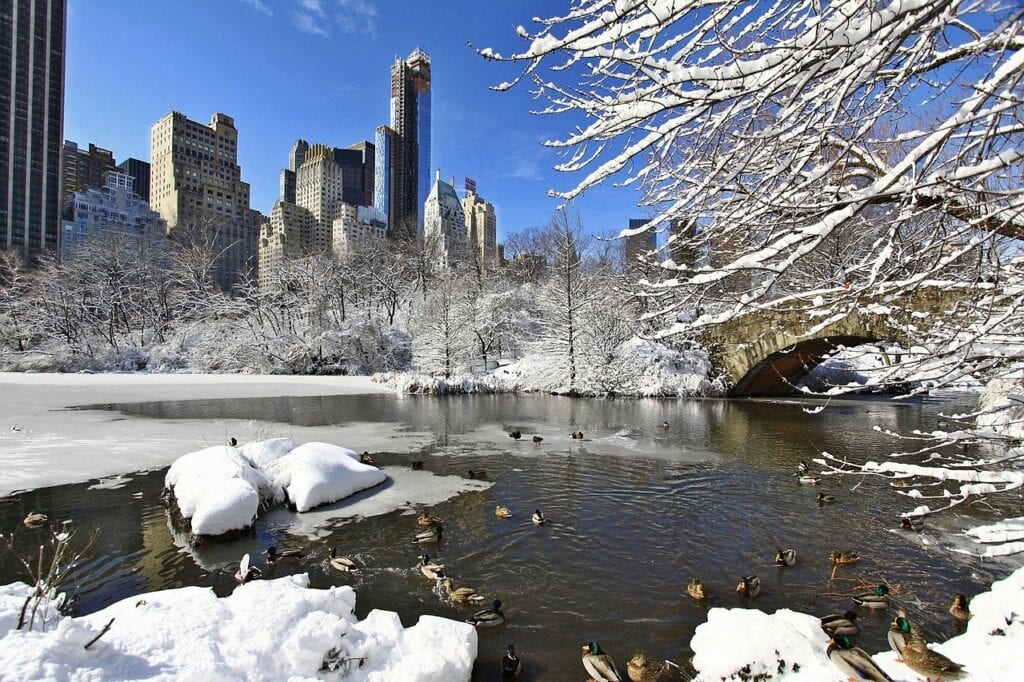
Whether you’re hunting or simply duck watching, there are tons of different duck options to keep an eye out for during every season in New York.
In fact, there are exactly 24 different duck species in the Empire State, and we go over each option for you here. You’ll soon know all about the different duck species in New York and hopefully, even be able to tell them apart from each other.

The 24 Breeds of Ducks in New York (with Pictures)
1. Mallards
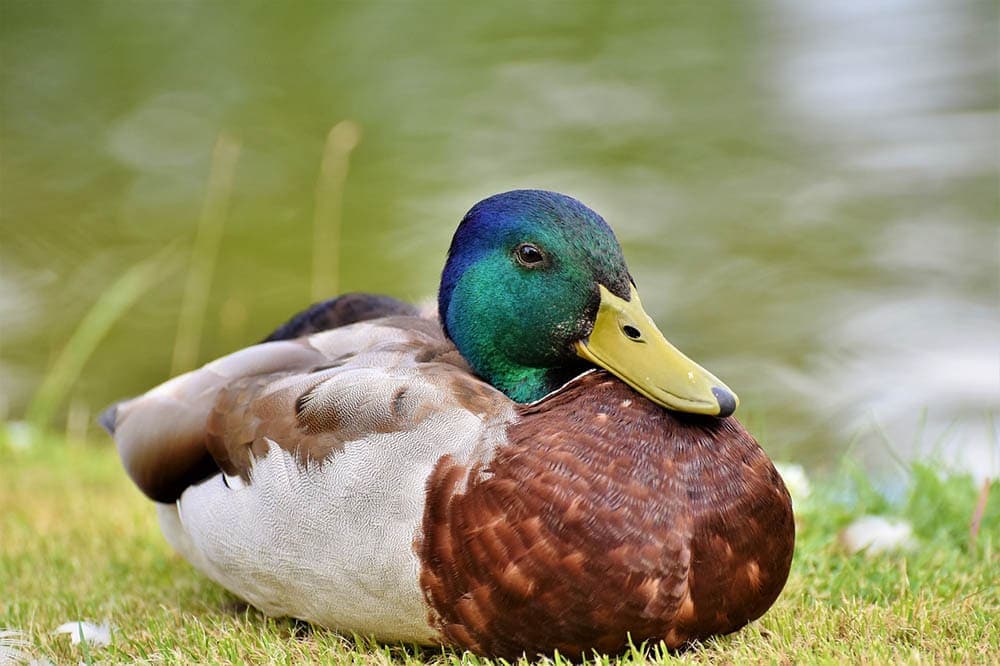
| Duck Classification: | Puddle Duck |
| Population: | 19 million |
| Weight: | 1.6 to 3.5 pounds |
| Length: | 20 to 26 inches |
| Colors: | Brown, green, and gray |
The mallard is probably the most recognizable duck in the United States, and with a population number close to 19 million, it’s not hard to see why they’re everywhere. They thrive around humans, and you can find them near lakes, rivers, ponds, and just about any other water source.
2. Black Ducks
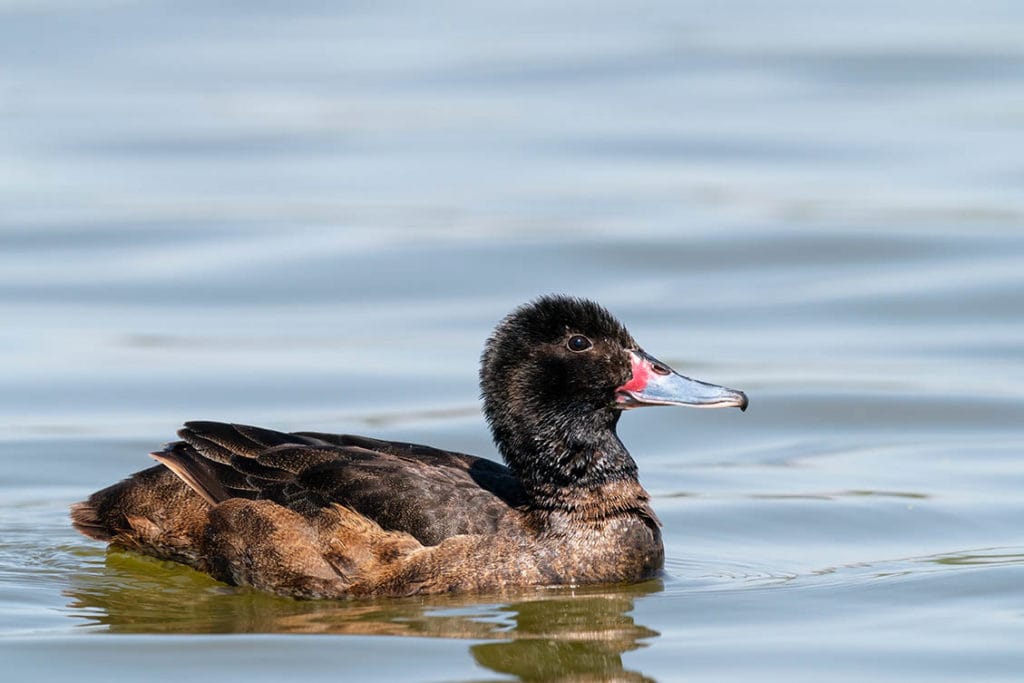
| Duck Classification: | Puddle Duck |
| Population: | 400,000 |
| Weight: | 1.6 to 3.6 pounds |
| Length: | 19 to 25 inches |
| Colors: | Black, white, and gray |
While mallards are everywhere, the black duck is much rarer. They’re also extremely skittish, and their population numbers are on the decline. Back in the ‘60s, hunters took about 800,000 a year. Today’s conservation efforts limit that number closer to 100,000.
3. Blue-Winged Teal
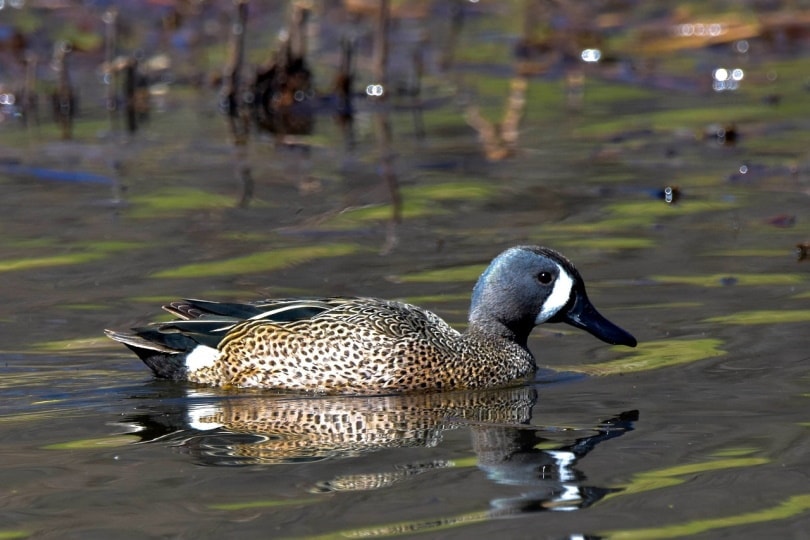
| Duck Classification: | Puddle Duck |
| Population: | 6 million |
| Weight: | 0.75 to 1.25 pounds |
| Length: | 14 to 16 inches |
| Colors: | Dark gray, white, light blue, and green |
There are tons of blue-winged teal ducks out there. They’re much smaller than mallards, though they are larger than their green-winged teal cousins.
4. Green-Winged Teal

| Duck Classification: | Puddle Duck |
| Population: | 7.7 million |
| Weight: | 0.5 to 1.5 pounds |
| Length: | 12 to 15 inches |
| Colors: | Gray, white, cinnamon brown, and green |
With population numbers just south of 8 million, there are quite a few green-winged teal ducks out there. However, compared to just about any other duck, especially in New York, green-winged teal ducks are tiny. Sometimes, these ducks barely weigh half a pound!
5. Wood Ducks

| Duck Classification: | Puddle Duck |
| Population: | 3.5 million |
| Weight: | 1 to 2 pounds |
| Length: | 18.5 to 21.5 inches |
| Colors: | Chestnut brown, green, black, and white |
If you’re looking for a puddle duck with a striking appearance, a wood duck has to be near the top of your list. Males have ornate patterns all over their chests, and their coloring is an iridescent chestnut and green hue that shimmers in the light.
6. Pintails
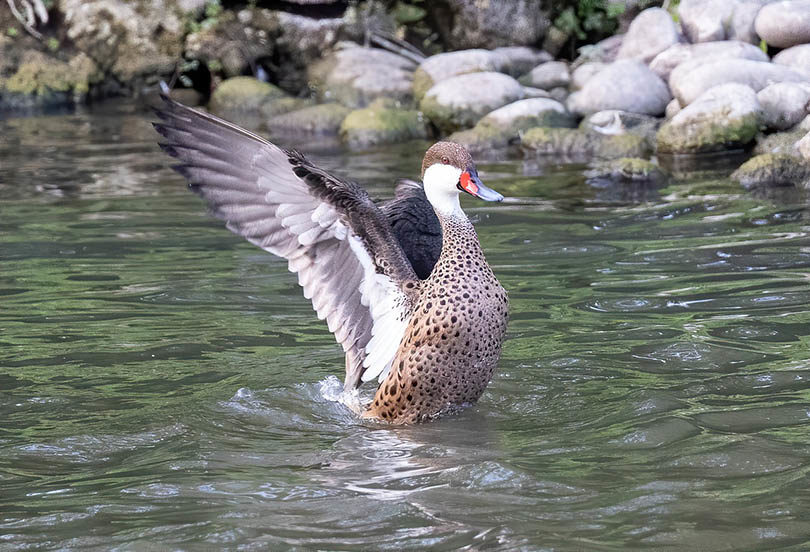
| Duck Classification: | Puddle Duck |
| Population: | 2.3 million |
| Weight: | 1 to 3 pounds |
| Length: | 25 to 29 inches |
| Colors: | White, brown, gray, and black |
Pintails have population numbers north of 2 million, so they’re a fairly common sight. They’re smaller than mallards and black ducks but larger than any other puddle ducks in New York.
7. Canvasback
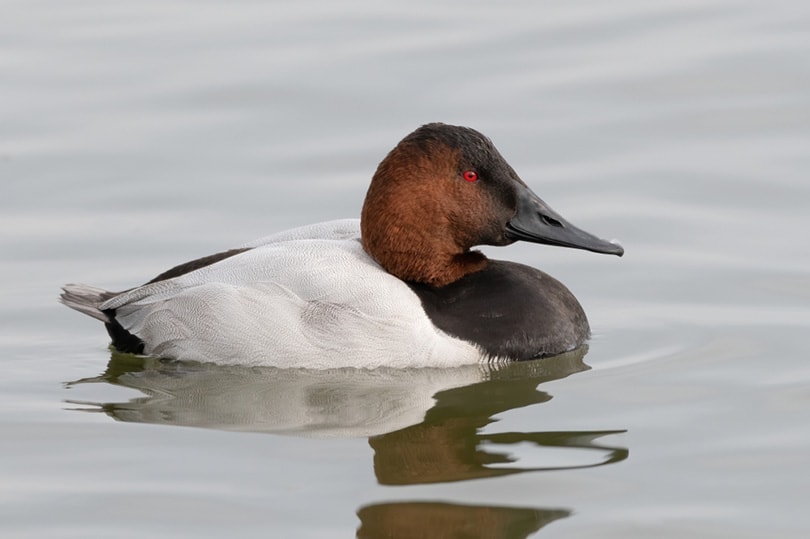
| Duck Classification: | Diving Duck |
| Population: | 700,000 |
| Weight: | 2 to 3.5 pounds |
| Length: | 19 to 22 inches |
| Colors: | Chestnut brown, black, white, and pale brown |
Compared to many other ducks on this list, it’s a bit challenging to spot a canvas back. They hang out in deep lakes, ponds, and coastal inlets and have a clear white body paired with a chestnut brown head and black feathers along their chest.
8. Redhead
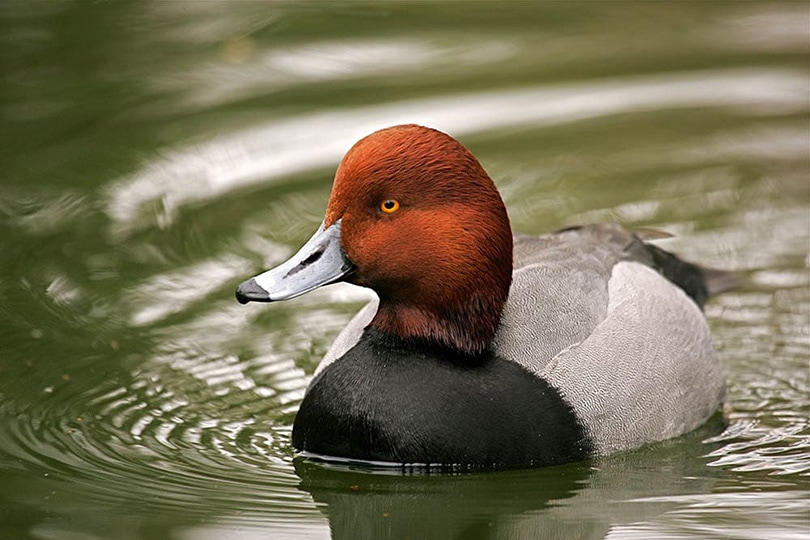
| Duck Classification: | Diving Duck |
| Population: | 1 million |
| Weight: | 2 to 2.5 pounds |
| Length: | 18 to 22 inches |
| Colors: | Cinnamon red, black, gray, and brown |
Redhead ducks are diving ducks and are similar in appearance to canvasback ducks. However, redhead ducks have longer sloped foreheads, with a more angular appearance.
The males do have a bright red head, though, with a white body and black chest.
9. Ring-Necked Duck

| Duck Classification: | Diving Duck |
| Population: | 2 million |
| Weight: | 1 to 2 pounds |
| Length: | 15 to 18 inches |
| Colors: | Brown, white, gray, and black |
While you can find ring-necked ducks in New York, they are rarer there. They have boxy heads that make them easy to tell apart from other ducks, and the males are almost entirely black with white wings. They also have a white band around their beak, making them easy to spot.
10. Greater Scaup

| Duck Classification: | Diving Duck |
| Population: | 3.5 million |
| Weight: | 1.6 to 3 pounds |
| Length: | 15.5 to 22 inches |
| Colors: | Black, white, and green |
The greater scaup and the lesser scaup are almost identical ducks, with the most notable difference being their size. The greater scaup can weigh up to 3 pounds, and there are roughly 3.5 million of them worldwide.
11. Lesser Scaup

| Duck Classification: | Diving Duck |
| Population: | 3.8 million |
| Weight: | 1 to 2.4 pounds |
| Length: | 15 to 19 inches |
| Colors: | Black, white, and purple |
The lesser scaup is the most common diving duck in New York, but the population numbers are extremely similar to the greater scaup. Some people refer to this duck as the little bluebill or the broad bluebill duck because they have a light-blue bill that is easy to spot.
12. Common Goldeneye
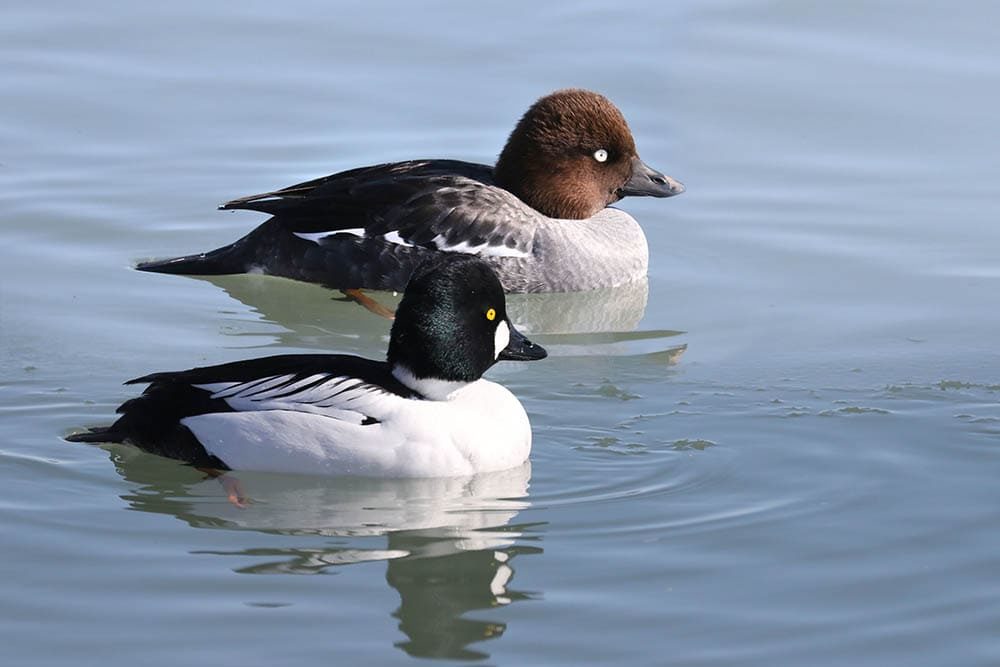
| Duck Classification: | Diving Duck |
| Population: | 1 million |
| Weight: | 1.5 to 2.5 pounds |
| Length: | 16 to 20 inches |
| Colors: | Black, white, and green |
While the common goldeneye shares James Bond’s nickname, that’s where the similarities end. The common goldeneye gets their name from the actual golden color of their eye, which stands out on their darker-colored head.
13. Ruddy Duck

| Duck Classification: | Diving Duck |
| Population: | 650,000 |
| Weight: | 0.7 to 1.8 pounds |
| Length: | 14 to 17 inches |
| Colors: | Black, white, gray, and brown |
The ruddy duck is the least populous diving duck, and their numbers seem to be dwindling fast. Still, during the warm months, you can see plenty of ruddy ducks frequenting the bays and deep lakes of New York.
14. Bufflehead
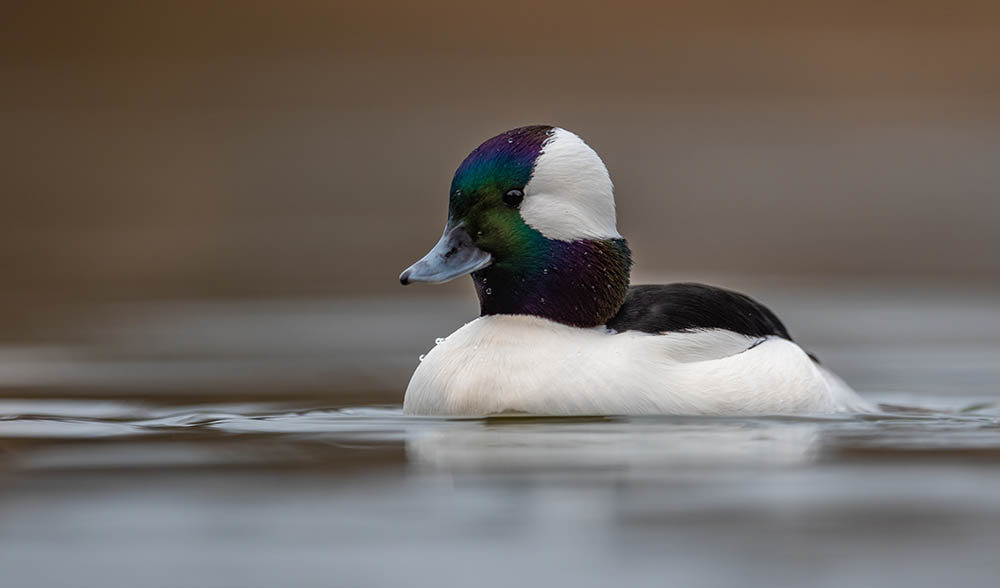
| Duck Classification: | Diving Duck |
| Population: | 1.4 million |
| Weight: | 0.75 to 1.35 pounds |
| Length: | 13 to 16 inches |
| Colors: | White, black, green, and purple |
The bufflehead is the smallest diving duck that you can find in New York. Most bufflehead ducks weigh about 1 pound, and the males have unique heads that make them easy to tell apart from other ducks. The top of the head is green, followed by a white band, which is immediately followed by a band with a purple tinge.
15. White-Winged Scoter

| Duck Classification: | Sea Duck |
| Population: | 800,000 |
| Weight: | 2 to 4 pounds |
| Length: | 19 to 23 inches |
| Colors: | Reddish-orange, gray, brown, and white |
New York is near the south end of the white-winged scoter’s range, so you’ll only see them there during the warm months. They’re not quite as common as mallards, but they’re not rare either.
16. Surf Scoter
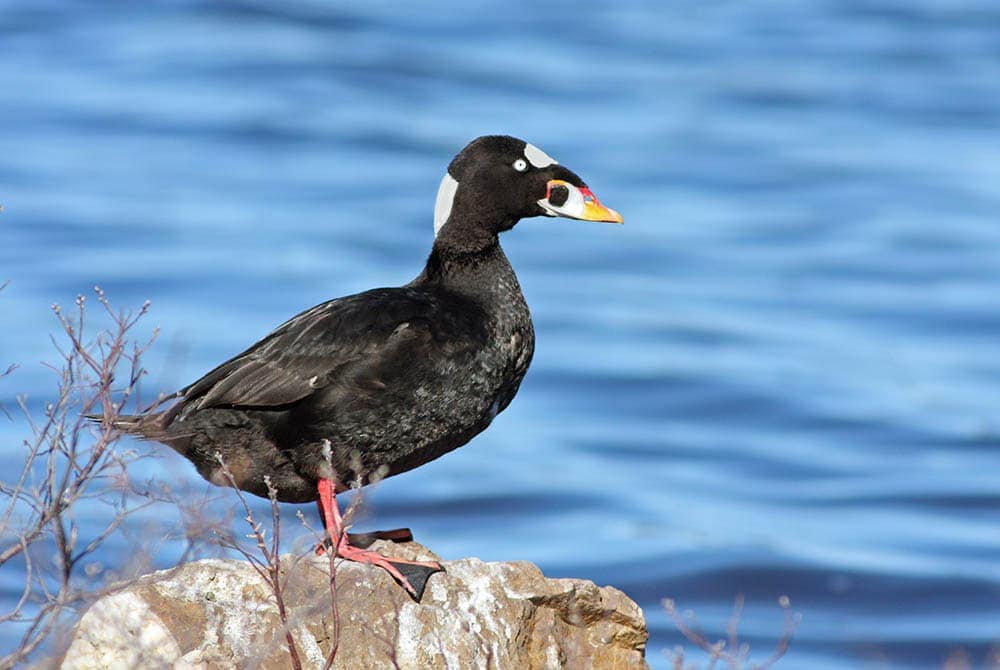
| Duck Classification: | Sea Duck |
| Population: | 1.3 million |
| Weight: | 2 to 3 pounds |
| Length: | 19 to 23.5 inches |
| Colors: | Black, orange, white, gray, and brown |
The surf scoter is a duck that you’ll find along the coastal waters during the winter months. During the summer, they head up to northern Canada to nest and breed, making the winter water around New York feel relatively warm.
17. Black Scoter

| Duck Classification: | Sea Duck |
| Population: | 830,000 |
| Weight: | 1.9 to 2.5 pounds |
| Length: | 17 to 19.5 inches |
| Colors: | Black or brown |
The black scoter is a duck that comes down from the frozen Canadian tundra to visit the coastal waters of New York during the winter months. Males are entirely black except for their beak, which usually has a yellow tinge.
18. Common Eider

| Duck Classification: | Sea Duck |
| Population: | 4 million |
| Weight: | 3 to 4.5 pounds |
| Length: | 20 to 28 inches |
| Colors: | Black, white, gray, gray, and brown |
While the common eider is a winter-visiting duck to New York, they don’t often travel inland.
They have large population numbers, making it much more likely to spot one of these black-and-white ducks if you’re looking at the coastal waters during the winter months.
19. King Eider

| Duck Classification: | Sea Duck |
| Population: | 900,000 |
| Weight: | 2.6 to 4.6 pounds |
| Length: | 18.5 to 20.2 inches |
| Colors: | Blue, green, orange, black, and white |
While the king eider might have a similar name as the common eider, one look at each of their beaks and they’re easy to tell apart. Male king eiders have a bulbous appearance to their beaks that makes them stand out compared to other ducks in New York.
20. Long-Tailed Duck

| Duck Classification: | Sea Duck |
| Population: | 3.2 million |
| Weight: | 1.5 to 2.5 pounds |
| Length: | 16 to 18.5 inches |
| Colors: | White and black |
The long-tailed duck is a small sea duck, and they live up to their name. Their tails are long and protrude upward when they’re swimming in the water. This makes them quite noticeable and easy for you to identify them.
21. Harlequin Duck
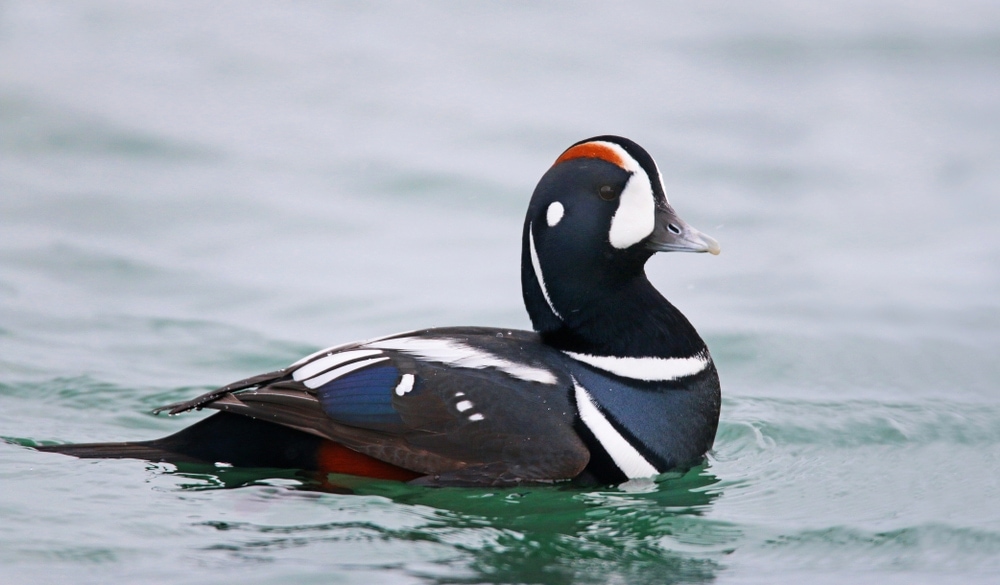
| Duck Classification: | Sea Duck |
| Population: | 250,000 |
| Weight: | 4.5 to 5.5 pounds |
| Length: | 14 to 20 inches |
| Colors: | Blue, white, and chestnut |
If you’re looking for the most unique looking sea duck in New York, that title has to go to the harlequin duck. They have white, black, and grayish-blue bands throughout their body, and the coloring around their face is incredibly unique. If you see a harlequin duck, you’re not going to mistake them for anything else.
22. Hooded Merganser
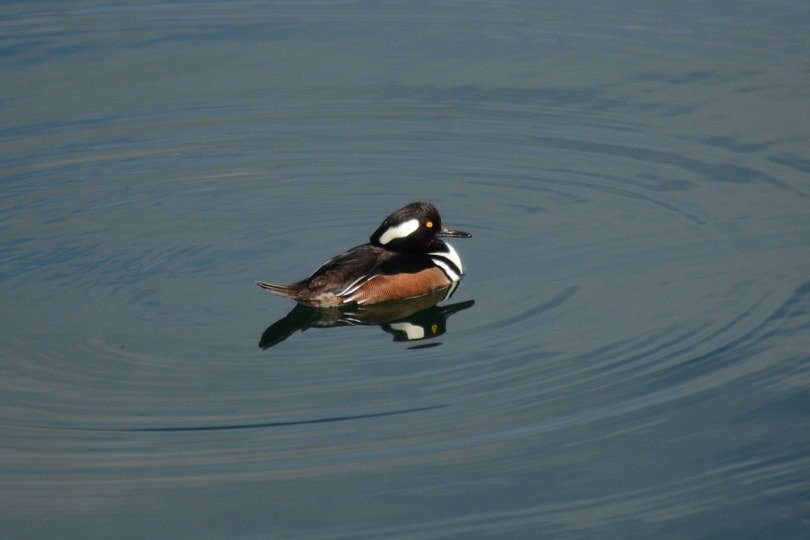
| Duck Classification: | Merganser |
| Population: | 325,000 |
| Weight: | 1 to 1.5 pounds |
| Length: | 16 to 19 inches |
| Colors: | Black, white, and chestnut brown |
The hooded merganser is a permanent resident in New York, making them one of the rare ducks that you can see in any season. They’re also easy to identify due to their unique head feathers. However, their dwindling population does mean they’re not as plentiful as other ducks.
23. Red-Breasted Merganser

| Duck Classification: | Merganser |
| Population: | 550,000 |
| Weight: | 1.75 to 3 pounds |
| Length: | 20 to 25 inches |
| Colors: | Brown and gray |
Like most sea ducks, the red-breasted merganser can be spotted off coastal waters in New York during the colder winter months. They have spiked head feathers that give them an unkempt appearance and make them easy to tell apart from other ducks.
24. Common Merganser
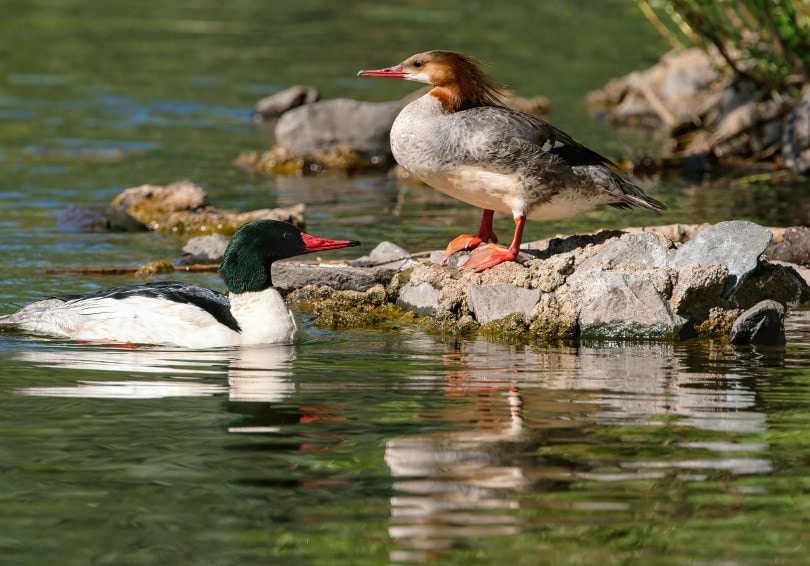
| Duck Classification: | Merganser |
| Population: | 2 million |
| Weight: | 2 to 4.75 pounds |
| Length: | 21 to 28 inches |
| Colors: | White, green, gray, and cinnamon brown |
The common merganser outnumbers both the red-breasted and hooded merganser combined, making it easy to understand how they got their name.
You’ll only see the common merganser in New York during the warm months, but there are quite a few of them. They have long beaks and longer head feathers, but neither are as pronounced as those of the hooded or red-breasted merganser.

Final Thoughts
Whether you’re just interested in watching ducks or love watching your dog collect them and you live in New York, there are tons of duck species for you to check out! Hopefully, this guide has armed you with all the information that you need to go out and get exactly what you’re looking for.
Featured Image Credit: PublicDomainPictures, Pixabay
Table of Contents
- The 24 Breeds of Ducks in New York (with Pictures)
- 1. Mallards
- 2. Black Ducks
- 3. Blue-Winged Teal
- 4. Green-Winged Teal
- 5. Wood Ducks
- 6. Pintails
- 7. Canvasback
- 8. Redhead
- 9. Ring-Necked Duck
- 10. Greater Scaup
- 11. Lesser Scaup
- 12. Common Goldeneye
- 13. Ruddy Duck
- 14. Bufflehead
- 15. White-Winged Scoter
- 16. Surf Scoter
- 17. Black Scoter
- 18. Common Eider
- 19. King Eider
- 20. Long-Tailed Duck
- 21. Harlequin Duck
- 22. Hooded Merganser
- 23. Red-Breasted Merganser
- 24. Common Merganser
- Final Thoughts
About the Author Robert Sparks
Robert’s obsession with all things optical started early in life, when his optician father would bring home prototypes for Robert to play with. Nowadays, Robert is dedicated to helping others find the right optics for their needs. His hobbies include astronomy, astrophysics, and model building. Originally from Newark, NJ, he resides in Santa Fe, New Mexico, where the nighttime skies are filled with glittering stars.
Related Articles:
Monocular vs Telescope: Differences Explained (With Pictures)
10 Types of Hummingbirds in Arkansas (With Pictures)
8 Types of Hummingbirds in Nebraska (With Pictures)
5 Types of Hummingbirds in Idaho (With Pictures)
3 Types of Hummingbirds in Mississippi (With Pictures)
8 Types of Hummingbirds in Kansas (With Pictures)
5 Types of Hummingbirds in West Virginia (With Pictures)
5 Types of Hummingbirds in Ohio (With Pictures)
